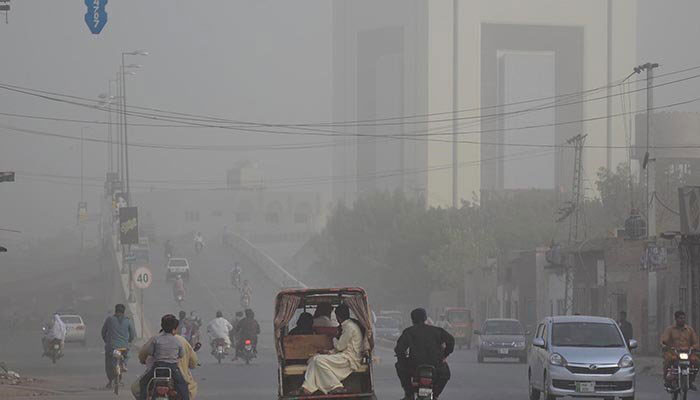Smog, air pollution and oil
In most countries, including Pakistan, road traffic is a major or even largest contributor to air pollution
November 08, 2019

Autumn has come and smog is in, more intensely in northern and central Punjab and especially in Lahore.
Smog, although short-lived, and causing invisibility and immediate health issues, brings into focus the larger and permanent air pollution issue. The reasons are no secret anymore, although some are more in focus like brick kilns and stubble-burning, dusty construction industry and dirty fuel consumption by SMEs. The contribution of traffic congestion and pollution and fuel quality thereof is not in the limelight to the extent that it should be. It is the largest contributor to air pollution in all major cities of the country. We will focus on it in the following and posit some suggestions to improve the situation in this respect.
In most countries, including Pakistan, road traffic is a major or even largest contributor to air pollution. Air pollution has dangerous health effects causing asthma, bronchitis, heart, lung and eyes issues and other diseases. Sulfur in oil is a major contributor in traffic pollution. NOx is created by combustion in automotive engines. Both contribute to particulate matter emissions. Unburnt fuel and CO production due to inadequate combustion is also a major cause. Older vehicles and motorcycles produce the latter kind of emissions more.
Motorcycles, being small, are considered by people to be benign. However, motorcycles emit 10 times more emissions than cars due to engine inefficiencies and inadequacy and the lesser space for corrective equipment. Newer vehicles with catalytic converters and electronic combustion control fewer emissions. But we have older vehicles and motorcycles. Half of the country’s total gasoline (petrol) is consumed by motorcycles and the population of motorcycles is increasing by leaps and bounds.
Read also: Lahore’s smog hits worst levels: Citizen’s report, officials silent
In all vehicles — motorcycles, cars and trucks and buses etc — petrol and diesel are used. Both fuel quality and engine efficiencies (in the broader sense of the word) are in need of major improvements in Pakistan. Developed countries have done it and are continuously improving the technology, both in terms of fuel and engine quality.
Fuel and engine standards, generally known as Euro-standards, have been introduced. Mainly, sulfur has been targeted among others. There used to be 5000 ppm (parts per million) sulfur in petrol and diesel earlier. Now, under Euro-VI standards, literally, there would be no sulfur. Euro V standards allow some sulfur at 10 ppm. Automotive engines are also required to burn this high standard fuel. New vehicles are already being produced to this standard.
Where are we in this respect? We are stuck at Euro-2 and that has been introduced lately. Not only that, we are also stuck with metal additives like Manganese (Mn) for improving the Octane Number (to improve engine knocking characteristics). There are slightly more expensive, non-metallic options, which can be used.
The other solution is an alternative oil refining process that may require major alteration in our old oil refineries. Oil refineries have been opposing the improvement in fuel standards. It requires investments to install the additional equipment to remove sulfur. Fortunately, sulfur removal does not require major alterations in existing oil Refineries but does require additional equipment for sulfur treatment or reduction. The government did provide incentives to oil refineries for modernization by introducing deemed duty (five percent tariff protection in product prices). The improvements have not occurred. There is controversy around it which should be sorted out by the government.
Read also: Lahore smog: Here’s what you can do to keep yourself safe
The general argument given in such cases is that we are poor and underdeveloped and thus cannot afford the costs involved in pollution control activities or for that matter in adopting new technologies and products-a neat prescription for suffering and remaining under-developed. The opposite is true in many cases. New technology is cheaper and more efficient. In fact sticking to older technologies becomes more expensive due to market reasons.
The availability of low quality, pollution producing fuels would become restricted by the day and such fuels may become more expensive or unavailable. It is already happening. Kuwait Petroleum which supplies 50 percent of Pakistan’s diesel requirements has intimated that it would no longer be able to supply lower than Euro-V product, having 10 ppm sulfur. Instead of receiving the news with pleasure, if not glee, it has caused uneasiness in our oil industry. Consumers and all others are happy that without any investments, better quality oil would be available. But our oil industry? They have their limitations and constraints, some understandable and some not.
What is India, stuck with identical or even more poverty and socio-economic degeneration, doing in this respect? India has already adopted EURO-IV (with 50 ppm sulfur) and is going to Euro-V or VI by 2020. Admittedly, there are two markets in India — poor and well to do; urban and rural. The coverage and implementation of standards in India are reportedly 50 per cent. Still, it is a 50 per cent reduction in pollution, not a mean achievement.
We may have to allow low quality high sulfur fuels for older vehicles and high quality low sulfur fuel for newer and new vehicles. This would also be a relief to the local oil refining industry. They would be able to continue to sell high sulfur fuel to the lower market segments including motorcycles, while imported fuel may be targeted at the higher end of the market. This sector may be unregulated as premium fuels are these days. Policymakers, however, may have a difficult job in weaving the aforementioned into the market structure of the oil industry. Lame arguments against the use of low sulfur fuels, that lubricity of the fuel is lost, can be met by requiring to add additives for improving lubrication. It is technically feasible.
As for motorcycles, perhaps not much can be done, although conversion to CNG and EV are possible. CNG auto-rickshaws are already there. Two-stroke engines are the most polluting. Two-stroke engine motorcycles should be discouraged and ultimately banned. Electrical motorcycles are reportedly available in the local market. In-fact, EV is a counter-technology for all types of vehicles. EVs remove pollution from congested areas and shift it to the hinterland, which is at least a part solution. Renewable energy would solve the problems completely and possibly may create problems of their own.
We would ask policymakers to go ahead towards adopting the low sulfur fuels standards by 2020. The maximum sulfur level that can be tolerated is 50 ppm (Euro-IV), while ideally it should be 10 ppm (EURO V or VI). All new vehicle imports and production should be on Euro-V. A vehicle fitness inspection system should be installed. Installation and good maintenance of catalytic converters should be encouraged (this is reportedly discouraged by our import tariffs). It is hoped that the new oil refineries that are being installed will be required to adopt EURO-V fuel processing.
Pollution is a larger national problem affecting the health and well-being of the people. It has been around for quite a while but has started worsening due to the rising population and resultant congestion. It affects the poor more. The Ministry of Health and the Ministry of Environment/Climate Change should have more effective consultations with the petroleum division for the development of a balanced and environment-friendly policy with respect to fuel standards.
The writer is a former member of the Energy Planning Commission and author of ‘Pakistan’s Energy Issues: Success and Challenges’.
Email: [email protected]
Originally published in The News









